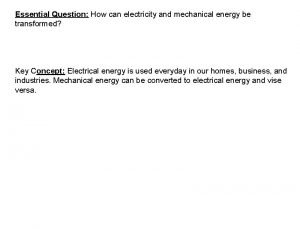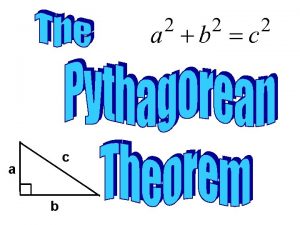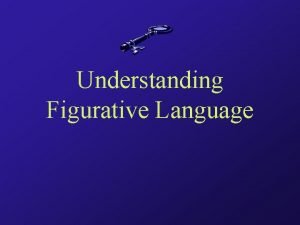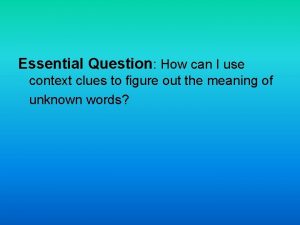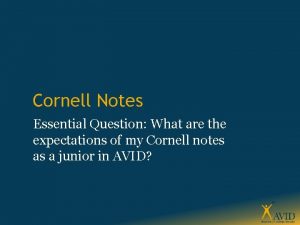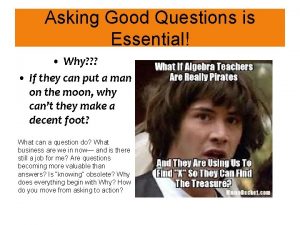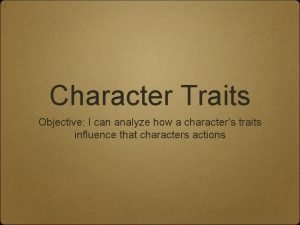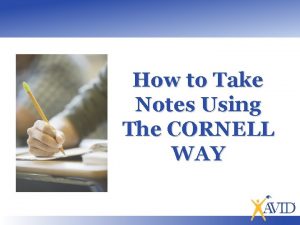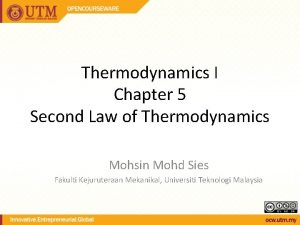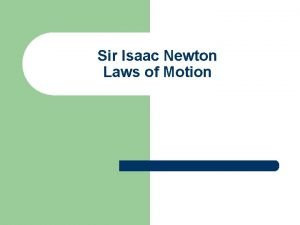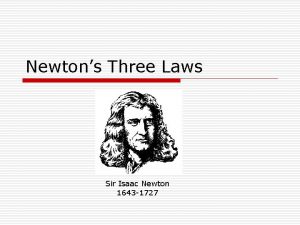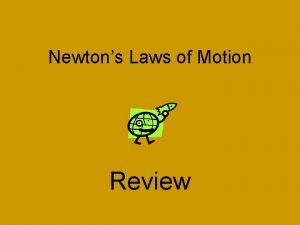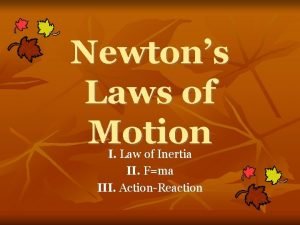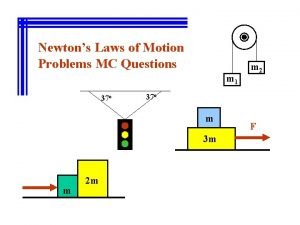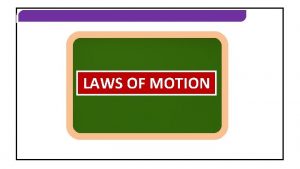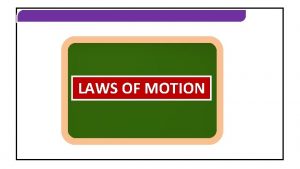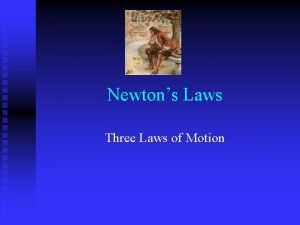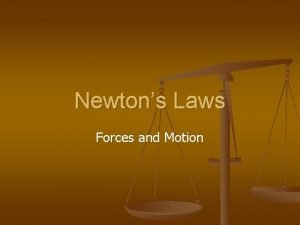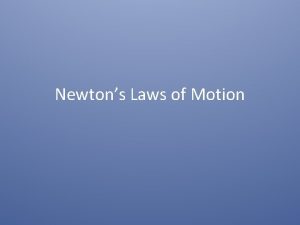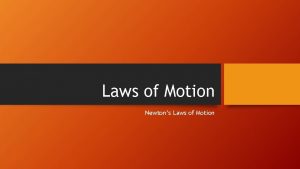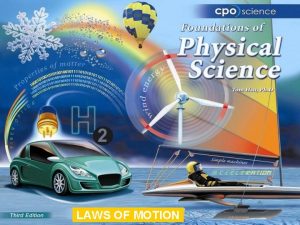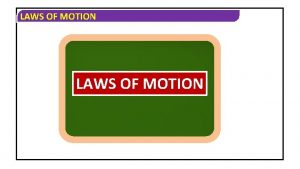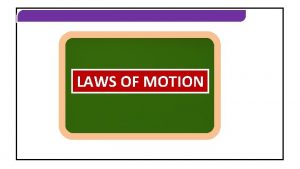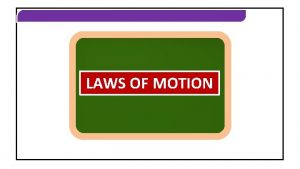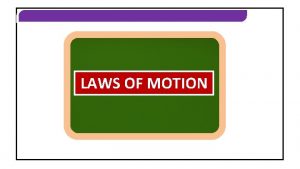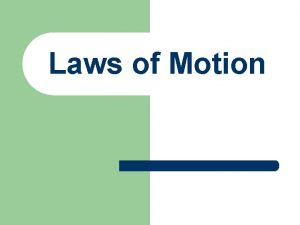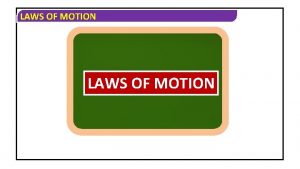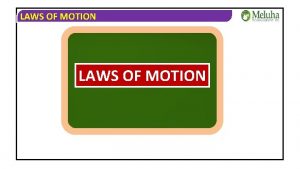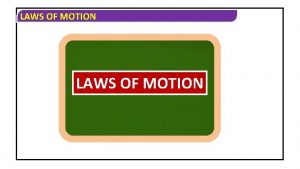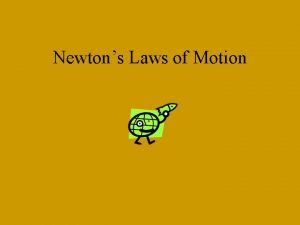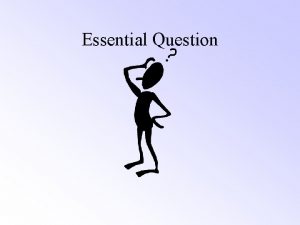The Laws of Motion Essential Question How do






























- Slides: 30

The Laws of Motion Essential Question: How do forces change to motion of an object? Original ppt from Mrs. West’s 8 th Grade Physics WEbsite http: //kawameeh. twpunionschools. org/subsites/hbormann/index. html Adapted by Denise Poston 2015

True or False? What do you think? Only some of the statements below are true. Can you identify them?

Part 1: Forces

Force �A push or pull on an object. � Described by: • STRENGTH • DIRECTION � A force gives an object energy to: • STOP MOVING • START MOVING • CHANGE DIRECTION

Types of Force � Contact Force � Non-Contact Force

Types of Force Contact Force Noncontact Force �A push or pull on one object by another that is touching it. � Contact be: forces can � Strong OR � Weak �A force that one object can apply to another object without touching it. � Examples Include: � Gravity � Magnetic Force � Electric Force

Strength and Direction of Forces � ARROWS can be used to show forces. LENGTH of an arrow shows the STRENGTH of the force. � The DIRECTION that the arrow points shows the direction in which the FORCE WAS APPLIED LONGER the � The stronger the force the arrow. � The

Strength and Direction of Forces � The SI unit force is the NEWTON � The symbol for Newton is N � One Newton = about the force you exert to lift a lime. � Named after: Sir Isaac Newton (founder of physics)

Part 2: Friction

Friction �A force that resists the motion of two surfaces that are touching. � Types of friction • STATIC FRICTION • SLIDING FRICTION • FLUID FRICTION

Static Friction � Friction that acts on objects that are not moving.

Sliding Friction � When solid objects slide over each other.

Fluid Friction �A force produced by a fluid (gases or liquids) Examples: engine oil, grease � Air resistance is affected by: • SHAPE • SIZE • MASS • a type of fluid friction • Upward force exerted on falling objects. *objects with more surface area have more air resistance*

What causes friction? 2 causes of friction � Surface roughness (texture) � Attraction negative) between particles (positive and

Have you changed your mind about any of these?

Part 3: Gravity How does the force of gravity change the motion of an object?


Gravity � An attractive force that exists between all objects that have mass. Force of gravity � On � All EARTH the force of gravity = 9. 8 m/s 2 objects fall to the Earth at an acceleration of 9. 8 m/s 2 due to the force of gravity.

The Law of Universal Gravitation � Sir Isaac Newton (1600’s) � The law states: �Factors All objects are attracted to each other by a gravitational force. The strength of force depends on the MASS of each object and the DISTANCE between them. Affecting Gravity • MASS • DISTANCE

Mass � The amount of matter in an object. Which object has more mass?

Gravitational Force and MASS � When the mass of one or both objects INCREASES the gravitational force between them also INCREASES � Regardless of the amount of mass an object has the FORCE ARROWS will be the SAME SIZE � Each object exerts the other object. SAME attraction on the


Gravitational force and DISTANCE � The attraction between objects DECREASES as the DISTANCE between the object INCREASES

Weight � The gravitational force exerted on an object. � Weight � Near is measured in NEWTONS Earth’s surface the object’s weight is the FORCE DUE TO GRAVITY

Weight and Mass on Earth � Weight and mass are related, but ARE NOT the � Weight can same. � Mass CHANGE due to GRAVITY DOES NOT change FORCE = MASS x ACCELERATION F= Mx. A Weight on Earth = MASS x 9. 8 m/s 2 (acceleration du to the force of gravity)

Examples: � What would an object with a mass of 10 kg weigh on Earth? � If your mass was 50 kg, what would your weight be on Earth?

Net Force � The combination of all the forces acting on an object. � To calculate the net force: ◦ If the forces act in the same direction they are added together. ◦ If forces act in opposite directions they are subtracted.

Combining Forces - Unbalanced � Forces acting on an object that combine and form a net force that is not zero. � Unbalanced forces cause an object to move. � Forces moving in the same direction are ADDED � Forces moving in the opposite direction are SUBTRACTED

Combining Forces – Balanced Forces � Forces acting on an object that combine and form a net force of ZERO. NO change in motion.

Any last revisions? Rewrite any false statements to make them true.
 Level questions
Level questions Characteristics of lipids
Characteristics of lipids Facts about montesquieu
Facts about montesquieu Essential questions for figurative language
Essential questions for figurative language Tina ordered a replacement part for her desk
Tina ordered a replacement part for her desk Essential question generator
Essential question generator Essential questions for pythagorean theorem
Essential questions for pythagorean theorem Language
Language Essential question about identity
Essential question about identity Use context clues in figuring out the meaning
Use context clues in figuring out the meaning What is the essential question in cornell notes
What is the essential question in cornell notes Open ended questions examples
Open ended questions examples Essential questions for multiplication
Essential questions for multiplication Essential question gif
Essential question gif Internal and external character traits
Internal and external character traits Cornell way
Cornell way Short story essential questions
Short story essential questions Pmm1 in thermodynamics
Pmm1 in thermodynamics Sir isaac newton
Sir isaac newton Three laws of newton
Three laws of newton What are the 3 laws of motion
What are the 3 laws of motion F=ma
F=ma Laws of motion
Laws of motion P = mv formula
P = mv formula Three laws of gravity
Three laws of gravity Laws of motion
Laws of motion Aristotle laws of motion
Aristotle laws of motion 3 law of newton
3 law of newton Newtons laws od motion
Newtons laws od motion Laws of motion
Laws of motion What are newtons 3 laws
What are newtons 3 laws





